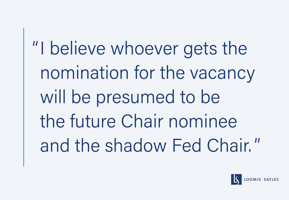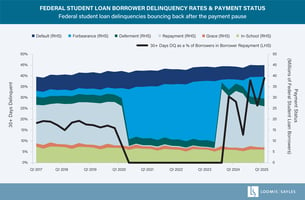
Investment Outlook
Investor risk appetite should remain strong as central banks ease policy in response to lower inflation.
Broadly speaking, ongoing expectations of artificial intelligence’s (AI's) transformative impact on the global economy could bolster investor sentiment during the next 6 to 12 months, and potentially much longer.
We believe certain sectors of the market, most notably growth equity, are likely to outperform other asset classes on the back of increased technology investment. That has been the case over recent history, but looking forward we expect positive absolute performance to broaden out.
Corporate credit and cyclical sectors of the equity market could benefit from the return of earnings growth beyond technology. We expect total return dispersion across industries to abate as underlying improvement in fundamentals broadens. In our view, solid earnings and interest rate cuts amid decent economic growth with declining inflation should lead to corporate credit outperformance over US Treasurys.
Key Takeaways
Our take on macro drivers and major asset classes at a glance.

Macro Drivers
In our view, inflation’s decline will be one of the most critical financial market drivers through 2024 and into 2025. The Federal Reserve (Fed) will likely begin cutting rates in September and continue at an every-other-meeting pace.

Corporate Credit
Credit market yields are near multi-year highs and could indicate good value.

Government Debt & Policy
Long-term bond yields across North America and Europe likely peaked for this cycle in October 2023.

Currencies
An ongoing developed market (DM) monetary easing cycle may usher in emerging market (EM) currency strength relative to the US dollar.

Global Equities
We believe positive trends across equity markets are likely to continue so long as earnings expectations remain robust.

Potential Risks
Financial asset valuations already reflect expectations for a soft landing, which leaves markets vulnerable to higher interest rates or very weak economic data.
Fixed income performance should improve as central banks around the world reduce interest rates. We expect defaults to remain very low and favor corporate credit and securitized assets versus Treasurys.
- We estimate US nominal GDP growth is likely to near 5.0% in 2024 before stepping back to 4.25% in 2025. In our view, the operating environment for corporates should remain positive, even in a moderately lower economic growth regime.
- We acknowledge signs of financial strain in lower-income consumers, but generally believe positive US consumption trends are likely to continue so long as the labor market remains in good standing.
- We believe capital expenditures will aid economic growth, largely driven by technology and research & development spending, which could rise at a strong pace over at least the next few quarters.
- We expect US core Personal Consumption Expenditure (PCE) inflation to average just under 2.5% for the first time this cycle during the third and fourth quarters. After that, we expect a slow drift toward 2.0% driven by less shelter and housing inflation.
- As inflation moderates globally, we expect central banks around the world to continue to, or to start, stepping away from restrictive policies. We think the Fed will likely cut rates in September and December of this year.
Global Inflation is Well Off Peak Levels and We Expect Further Progress
Rate cuts in response to lower inflation are adjustments that limit monetary restrictiveness; emergency cuts are different.
Source: LSEG Datastream, data as of 24 June 2024.
The chart presented above is shown for illustrative purposes only. Some or all of the information on this chart may be dated, and, therefore, should not be the basis to purchase or sell any securities. The information is not intended to represent any actual portfolio. Information obtained from outside sources is believed to be correct, but Loomis Sayles cannot guarantee its accuracy. This material cannot be copied, reproduced or redistributed without authorization.
Corporate credit spreads are historically tight, but we see room for compression if a soft landing plays out.
- We believe we are in the mid-expansion phase of the credit cycle. Conservative financial policies across industries appear to be driving stable expectations for corporates. Shareholder-friendly activity could accelerate as we move through the year but is unlikely to derail fundamentals, in our view.
- We expect limited downgrades within the investment grade space and historically low defaults around 3.5% within the high yield sector. We are closely monitoring sectors where commodity price volatility is a significant risk factor.
- Heavy investment grade issuance during the first half of 2024 likely signaled less supply in the second half. We believe this is a positive technical given strong demand for high-grade corporate credit.
- An “up-in-quality” theme is likely to continue within the high yield sector. In our view, BB and B rated credit spreads look rich, while CCCs look fairly valued relative to history.
- In Europe, we believe relief from higher funding costs is likely around the corner if the European Central Bank (ECB) continues cutting rates while profitability begins to accelerate.
- We would not shy away from credit because yields are at multi-year highs and an interest rate cutting cycle is on the horizon. Election-driven volatility could present opportunities to add credit exposure at wider spreads.
Election Risk is a Global Factor in 2024
We believe a stable fundamental backdrop can support credit markets.
Source: LSEG Datastream, data as of 14 June 2024.
The chart presented above is shown for illustrative purposes only. Some or all of the information on this chart may be dated, and, therefore, should not be the basis to purchase or sell any securities. The information is not intended to represent any actual portfolio. Information obtained from outside sources is believed to be correct, but Loomis Sayles cannot guarantee its accuracy. This material cannot be copied, reproduced or redistributed without authorization.
We believe disinflationary trends should remain in place, global supply chains have normalized and economic growth rates are likely to find long-term trend levels.
- Elections are a market-moving factor across the globe this year. The transition of power and potential policy reform will remain a key consideration for investors.
- Neither US presidential candidate appears interested in fiscal austerity, which means the US government budget deficit is not likely to improve over the near term.
- The fiscal position of the US government introduces the risk of higher long-term bond yields. However, investors do not appear overly concerned about the country’s long-term prospects.
- Inflation is likely on the decline. We think it will remain one of the most critical policy drivers, dictating just how much central banks can reduce rates.
- We believe that DM long-term yields can slide lower into 2025. We are most constructive on US duration and expect yields across the curve to shift lower once the Fed’s cutting cycle begins.
- We see value in local EM fixed income based on relatively higher yields and prospects for US dollar weakness. Investors could potentially benefit from foreign currency appreciation and interest income.
Short-Term Yields Will Be Pulled Lower as Central Banks Cut Policy Rates
Above-target inflation makes a trip back to near zero or negative rates highly unlikely.
Source: LSEG Datastream, data as of 14 June 2024.
The chart presented above is shown for illustrative purposes only. Some or all of the information on this chart may be dated, and, therefore, should not be the basis to purchase or sell any securities. The information is not intended to represent any actual portfolio. Information obtained from outside sources is believed to be correct, but Loomis Sayles cannot guarantee its accuracy. This material cannot be copied, reproduced or redistributed without authorization.
We think financial conditions are likely to remain easy in the US, especially if the Fed initiates a cutting cycle.
- US dollar strength is likely to subside once the Fed begins to ease policy. If signs of even more disinflationary pressure become evident, dollar weakness could become more pronounced, in our view.
- The US dollar is often perceived as a relative “safe haven” asset during periods of financial stress abroad. Currently, we see a number of geopolitical risks and reasons for caution, but believe the global economy remains in decent shape.
- A flight-to-quality bid looks unlikely to boost the dollar near term, but we do not expect material weakness either. We think capital flight out of the US dollar is also unlikely near term despite growing risks related to the government budget deficit.
- The US economy has been performing quite well relative to DM peers, which we believe could attract overseas investors to US credit and equity markets.
- We remain cautious about a potential upside surprise in China, where a growth impulse would be highly beneficial to neighboring EM countries and their currencies.
- We have a favorable view of foreign exchange exposure to Latin America, particularly Brazil, Colombia, and Chile.
US Dollar Indices Rallied Around 4% Year-To-Date as Fed Cuts Were Priced Out Of the Market, But That Dynamic Could Flip Heading Into 2025
Foreign currencies with high carry should outperform the dollar as the Fed cuts interest rates.
Source: LSEG Datastream, Bloomberg, Federal Reserve, data as of 14 June 2024.
The chart presented above is shown for illustrative purposes only. Some or all of the information on this chart may be dated, and, therefore, should not be the basis to purchase or sell any securities. The information is not intended to represent any actual portfolio. Information obtained from outside sources is believed to be correct, but Loomis Sayles cannot guarantee its accuracy. This material cannot be copied, reproduced or redistributed without authorization.
In our view, the US, Japan and emerging markets have the potential to produce double-digit year-over-year earnings growth for calendar year 2024.
- Several markets across the globe are near their 52-week or all-time highs and we believe there could be more upside. We believe most markets could see mid-single-digit total returns over the second half of 2024.
- We are keeping an eye on valuation, but in many cases markets are growing into what appear to be lofty price-to-earnings multiples.
- US technology and communication services have been the leadership groups and we do not think that is likely to change near term. That said, over the second half of 2024 we expect earnings growth in those industries to cool while lagging sectors like healthcare and energy begin to grow earnings again.
- We expect broadening participation in the rally as the underlying fundamental backdrop across sectors improves.
- Even if US large-cap profit margins consolidate for a few quarters, it would not necessarily be a negative development for the market in our view because operating margins are near all-time highs.
- We believe earnings per share (EPS) growth for the MSCI Europe Index is likely to be flat in 2024 but Bloomberg consensus indicates a 7.5% rebound in 2025. By that same measure, 2025 EPS is projected to be 7% for the MSCI Japan Index, 13% for the S&P 500 Index and 15% for the MSCI Emerging Markets Index.1
- Bull markets that span across regions tend to have the most staying power, and that is what we’re seeing with the exception of China. Earnings are the fundamental lynchpin backing our case for further upside.
S&P 500 2025 Earnings Expectations Have Been Remarkably Stable and Have Even Improved
Consensus expectations could be overly optimistic. Even so, we believe realized earnings within the range of current expectations would be favorable for markets.
Sources: LSEG Datastream, data as of 26 June 2024.
The chart presented above is shown for illustrative purposes only. Some or all of the information on this chart may be dated, and, therefore, should not be the basis to purchase or sell any securities. The information is not intended to represent any actual portfolio. Information obtained from outside sources is believed to be correct, but Loomis Sayles cannot guarantee its accuracy. This material cannot be copied, reproduced or redistributed without authorization.
While weaker economic data has been viewed favorably by markets, we are watchful for a line in the sand where recession risk creeps back into the market.
- We believe AI is a long-term secular trend that will take years to play out. Caution may be warranted given the impact a narrow group of large companies has on US equity benchmark performance.
- A soft landing requires soft or even weak economic data. Investors may grow skittish and recession anxiety could return if consistently weak data comes through.
- If a growth scare occurs, we could see a 10% correction in equity markets and credit spread widening. In our view, current market pricing does not reflect downside risks around the economy.
- A more robust economy could send US Treasury yields higher, pressure credit and equity valuations, and price Fed rate cuts out of consensus expectations.
- We also see risk in being underinvested at this point in the cycle. Corporate health appears to be in good shape and we expect it to be a key positive driver for equities, credit and emerging market currencies.
Asset Class Outlook
We prefer US duration over international duration. We expect EM local fixed income and currencies to perform well if the Fed cuts interest rates. We prefer US growth equity exposure but anticipate a rally in global markets as well.
Author
Craig Burelle
Global Macro Strategist, Credit
Endnotes
1 Source: Bloomberg, as of 21 June 2024.
Disclosure
This marketing communication is provided for informational purposes only and should not be construed as investment advice. Any opinions or forecasts contained herein reflect the subjective judgments and assumptions of the authors only and do not necessarily reflect the views of Loomis, Sayles & Company, L.P. Investment recommendations may be inconsistent with these opinions. There is no assurance that developments will transpire as forecasted and actual results will be different. Data and analysis do not represent the actual or expected future performance of any investment product. Information, including that obtained from outside sources, is believed to be correct, but Loomis Sayles cannot guarantee its accuracy. This information is subject to change at any time without notice.
Past performance is no guarantee of future results.
Any investment that has the possibility for profits also has the possibility of losses, including the loss of principal.
Diversification does not ensure a profit or guarantee against a loss.
Market conditions are extremely fluid and change frequently.
Commodity, interest and derivative trading involves substantial risk of loss.
Indices are unmanaged and do not incur fees. It is not possible to invest directly in an index.
LS Loomis | Sayles is a trademark of Loomis, Sayles & Company, L.P. registered in the US Patent and Trademark Office.
SAIFvlrzzmd8


